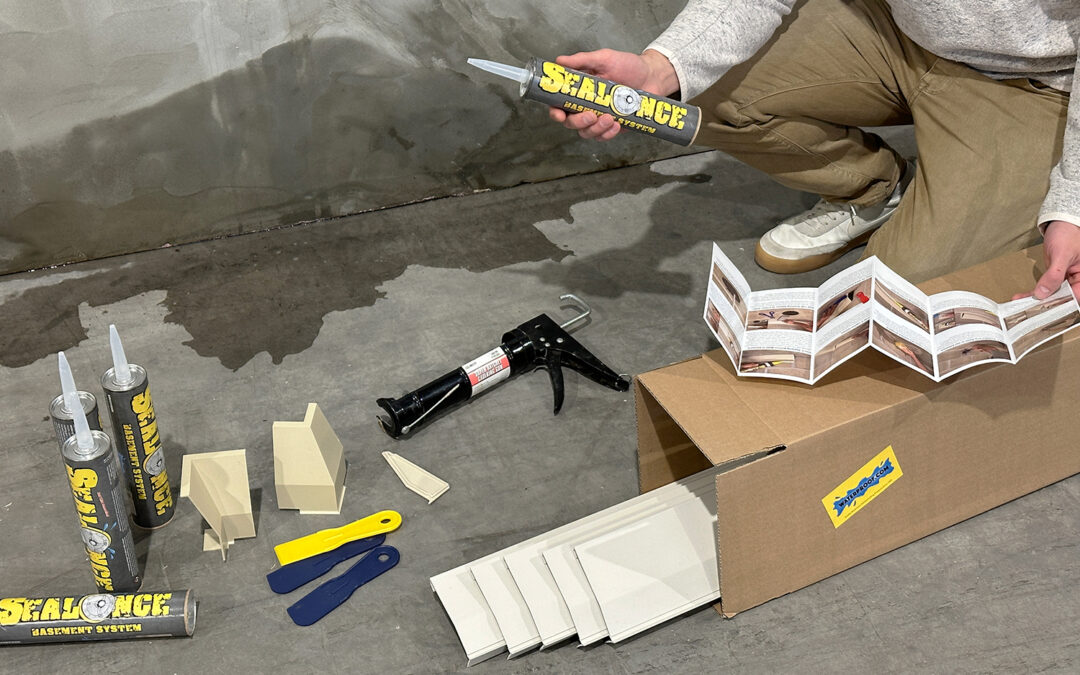When it comes to waterproofing your home, there are two main methods: exterior and interior waterproofing. Interior waterproofing focuses on managing water that has already entered your basement, while exterior waterproofing prevents water from entering in the first place.
Think of it this way: interior waterproofing is a corrective solution and exterior waterproofing is preventative.
What is Exterior Waterproofing?
Definition: Exterior waterproofing involves applying a waterproof coating or membrane to the outside of a building’s foundation walls. This creates a barrier that prevents water from penetrating the foundation, protecting your home from potential water damage and structural issues.
How Exterior Waterproofing is Installed
The installation process involves several key steps:
- Waterproofing Membrane: A durable waterproof membrane is applied to the exterior foundation walls to block water from seeping through.
- Drainage Systems: A French drain system or drain tile installation helps redirect water away from the foundation, further reducing water buildup.
- Waterproof Coating: Protective coatings are applied to seal and protect walls from water and moisture infiltration.
Pros
- Stops Water at the Source: By preventing water from reaching your foundation, you eliminate water damage and hydrostatic pressure before it becomes a problem.
- Long-Term Foundation Protection: Is less invasive and protects the foundation from structural issues, ensuring your home’s stability for many years.
- Enhanced Property Value: Adds long-term value to your home by preventing costly repairs and maintaining its structural integrity.
- Ideal for New Construction: The most cost-effective time is during the building phase as the foundation is already exposed and wouldn’t require extra excavating.
Cons
- Higher Cost and Time: Can be expensive and time-consuming due to the excavation required to access the foundation walls.
- Landscaping Disruption: Disrupts landscaping and exterior walls, requiring restoration after waterproofing is complete. Not an ideal waterproofing option for existing homes.
- Difficult Repairs: If the work is done incorrectly, fixing it can be complex and costly. If the exterior waterproofing system fails, you’ll likely need an interior waterproofing system to correct the issue.
- Limited Access to System: Exterior waterproofing systems often lack direct access to the waterproofing channel for maintenance and flushing systems.
What is Interior Waterproofing?
Definition: Interior waterproofing involves tapping into the source of the wet basement and properly managing and collecting the seepage and draining it out of the basement. This method typically uses foundation drainage channels and a sump pump system to collect and drain the water out of the home.
How Interior Waterproofing Works
Interior basement waterproofing addresses common issues like leaky foundations, seeping concrete cracks, moisture problems, hydrostatic pressure, mold growth, dampness, and water buildup.
The most common location water enters a basement is through the joint where the foundation walls and floor meet, often referred to as the cold joint or cove joint in a basement. Interior waterproofing systems work by tapping into the source of the wet basement to reduce the hydrostatic pressure forcing the water into the home.
By managing water that has already entered the space, it helps create a healthier environment while protecting your home from long-term damage.
Pros
- Cost-Effective and Non-Invasive: Doesn’t require extensive excavation, making it more affordable and easier to install.
- Flexible Application: Can be installed in almost any home, regardless of age or current condition. There are a variety of waterproofing systems designed to remedy any level of wet basement from above-floor channels ideal for monolithic foundations or drain tile channels installed below the concrete floor next to a home’s foundation.
- Year-Round Installation: Can be implemented at any time of the year, regardless of external weather conditions.
Cons
- Reactive Rather than Preventative: Doesn’t stop water intrusion at the source – it only manages it after it has entered the foundation.
- Ongoing Maintenance: Systems like sump pumps and drainage channels require regular upkeep to remain effective.
- Finished Basements: If you have a finished basement, you’ll need to remove the finished areas to install the waterproofing system correctly.

Comparing Exterior and Interior Waterproofing: Choosing the Right Solution for Your Home
Deciding between exterior and interior waterproofing depends on various factors, including your home’s structure, the severity of water problems, and your long-term goals. Here’s a closer look at how they differ and when each method is appropriate.
Key Comparison Points
- Cost and Labor
- Exterior waterproofing involves excavation, which drives up costs and labor requirements. It’s often part of larger renovation or new construction projects, and necessary for homes with significant water issues.
- Interior waterproofing can be installed more quickly and at a lower cost, often without disrupting the home’s exterior.
- Effectiveness
- Exterior waterproofing stops water at the source, providing long-term protection for your foundation, but not accessible for maintenance, and if the exterior system fails you’ll need to remedy the issue with interior waterproofing.
- Interior waterproofing effectively manages excess water seepage from entering the basement, but if the basement is finished, demo of the finished work is required to install an interior waterproofing system.
- Applications
- Exterior waterproofing is ideal for new construction when the foundation is already exposed and application of exterior membrane or foundation drainage can easily be installed.
- Interior waterproofing is ideal for existing homes seeking a solution to their wet basements due to heavy rainfall or high water tables, where hydrostatic pressure consistently builds up around the foundation. Interior waterproofing systems can tap into the hydrostatic pressure to relieve it, then properly manage and drain the water out of the basement keeping the area dry.
- Longevity
- Exterior waterproofing offers a long-term solution for protecting your foundation, but it requires a larger upfront investment and is significantly more invasive for preexisting homes versus new construction.
- Interior waterproofing systems rely on components like sump pumps and drainage lines, which need regular maintenance and may need replacement over the lifetime of the home.
When to Choose Each Method
Exterior waterproofing is a great option for homes during the building process to help prevent seepage into the basement once finished. The cost is much more affordable during construction versus an existing home looking to solve a leaking basement. Exterior waterproofing is a great preventative measure for homes during construction and is often required by code depending on your location.
Alternatively, interior waterproofing is a great option for homes in areas with high groundwater levels or significant rainfall. If the water is entering your basement through the joint where the floor and walls meet or up through the middle of your concrete floor, an interior waterproofing system will collect and manage the water keeping the space dry. It’s a great option when you need a solution that doesn’t require exterior excavation or disruption to your property.
By evaluating your home’s specific needs and the extent of water problems, you can choose the waterproofing method that provides the right balance of protection, cost, and convenience.

Why Waterproof is Your Go-To Solution for Basement Waterproofing
Whether you’re a homeowner taking on a DIY basement project or a contractor servicing your local community, Waterproof.com has the expertise and products you need to get the job done right. For over 50 years, we’ve designed innovative, high-performing waterproofing systems trusted by both professionals and homeowners.
Waterproofing Kits for Homeowners
We make DIY basement waterproofing accessible with easy-to-install kits, including everything you need to ensure a dry basement.
- SealOnce Basement Waterproofing System – For basements that leak water where the interior walls and floors meet.
- Tiny Titan Sump Pump Kit – A compact sump pit that collects water from flooding and heavy rains.
- VaporBright Moisture Barrier Kit – For encapsulating your crawl space or basement walls.
- CRACK Foundation Wall Repair – Fixes wet and leaky basement cracks overnight.
- UnderGround Downspouts – Diverts roof-water runoff away from your home’s foundation.
Learn more about our DIY kits here
Supplies for Contractors
Contractors across the US and Canada rely on Waterproof.com for professional-grade products that simplify installation and ensure long-lasting results for their clients. From sump pump basins to crawl space encapsulation supplies and a line of exclusive professional waterproofing systems manufactured in-house, our products are designed to increase efficiency, save time, and deliver results that clients trust.
Learn more about our contractor supplies here
Your Partner in Basement Protection
Don’t let water damage take a toll on your home. Contact WATERPROOF.COM today!
Let us help you protect your basement for the long run with reliable, high-performing waterproofing systems.

